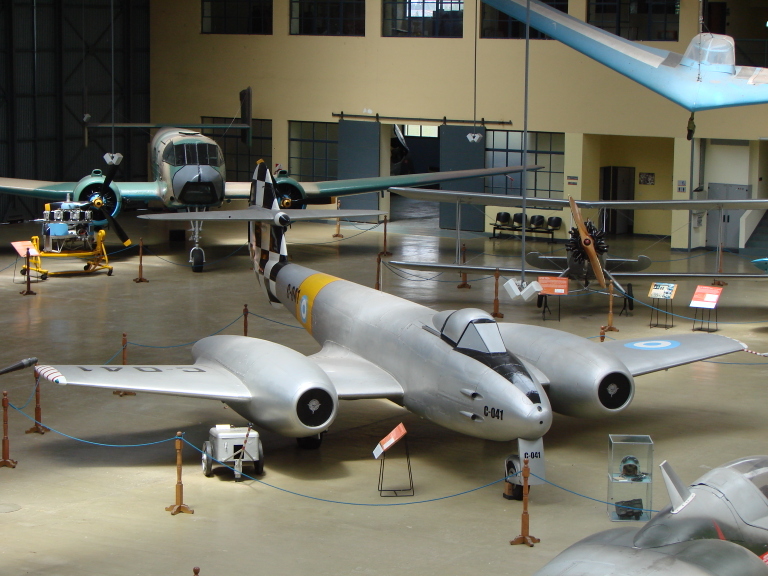Have I mentioned the Meteor before? I ought to look through the annals of this blog but I don’t honestly think I have. My friend Paul Bird the architect used to talk about form following function when we were students together, and to a certain extent the early jet aircraft were expressions of that philosophy. The Meteor is another of those iconic aircraft shapes which I associate with my childhood, or youth, and I do remember being excited when Airfix and Frog released their models of the F.3 and F.4 respectively.

The reason for this particular ramble is that my sister Hilary referred me to a UK news item about the retirement of an airworthy Meteor night-fighter at Bruntingthorpe over the weekend. I still haven’t worked out which one it is / was although there can’t be too many contenders. I have a feeling it must be NF.11 / TT.20 WM167 but I’ll be happy to be proved wrong.
I am struggling to remember if I’ve ever seen a Meteor flying around. I did take a photo of a very rusty example stored on the outer fringes of Duxford airfield in the early 80s. It was either F.4 VT229 or F.4 VT260, both of which are preserved in the USA. There was a Javelin next to it, if I recall correctly.
So that got me thinking. Where are the oldest Meteors located? I know I’ve seen the prototype DG202/G at Cosford, and someone on Wikipedia is at great pains to point out it’s the prototype F9/40 and was never actually called a Meteor. OK, fair enough, but after that?

- F9/40 DG202/G, first prototype with the RAF Museum. Picture above
- Meteor F.4 EE531, noted at the Midland Air Museum located at Coventry Airport near Baginton, Warwickshire. If you’re going to be strict about the F9/40, then this is the oldest complete production Meteor in the UK.
- Meteor F.4 EE549 at the Tangmere Military Aviation Museum (on the site of the former RAF Tangmere) Chichester, W. Sussex. EE549 was the “Star Meteor” which set the world absolute speed record of 616 mph on 7 September 1946.
Argentina? I know that the Fuerza Aérea Argentina received a number of ex-RAF and newly built Meteors. It turns out several of them are preserved and many of them are very old. Here’s a list of the older examples in the order of their former RAF serials, remixed from the Wikipedia page:
- Meteor F.4 I-027, ex-EE527, Museo Regional Interfuerzas, Santa Romana, San Luis. Four digits senior to EE531 at Bagington, this is in my view the oldest complete production Meteor extant.
- Meteor F.4 I-025, ex-EE532, displayed on plinth on the Avenue of the Air Force, outside the Escuela de Aviación Militar, Córdoba.
- Meteor F.4 I-029, ex-EE537, being restored for the Museo Regional
- Meteor F.4 I-019, ex-EE553, displayed on plinth at the Northern Roundabout of the Avenue Spinetto Santa Rosa, La Pampa. Painted as I-021, condition poor.
- Meteor F.4 I-014, ex-EE575, displayed on plinth in Goya, Corrientes.
- Meteor F.4 I-038, ex-EE587, Junin Aeroclub, Junin, Buenos Aires.
- Meteor F.4 I-041, ex-EE586, Museo Nacional de Aeronáutica de Argentina, Morón, Buenos Aires.
- Meteor F.4 I-031, ex-EE588, Either at the Liceo Aeronáutico Militar de Funes, Funes, Santa Fe, or Aeroclub Las Parerjas, Las Parjas.


For the benefit of the American readership there are actually four preserved Meteors as follows:
- Actually airworthy is Meteor T.7 N13Q, ex-G-BWMF, ex-WA591 at the World Heritage Air Museum in Detroit, MI
- Wouldn’t you know it. Kermit Weeks has Meteor F.4 N229VT, ex-VT229 under restoration or at least in storage at Fantasy of Flight, Polk City, FL.
- Meteor F.4 VT260 – (I must dig out my photo) is at Planes of Fame in Chino, California. (Picture below)
- Meteor NF.11/TT.20 WD592 is at the Air Force Flight Test Center Museum, Edwards Air Force Base, CA.

We then come to the issue of bits of old Meteors. I tracked down a couple in the UK just as I thought I’d finished writing this article.
The Imperial War Museum has what it describes as a cockpit section of F.3 EE416. This aircraft was delivered to Martin-Baker in November 1945, and it was from EE416 that the very first live ejection test in the UK was carried out on 24 July 1946.
The Jet Age Museum in Gloucester has the cockpit and nose undercarriage leg of F.3 EE425 which was presented to the museum by the son of the former Chief test Pilot at Gloster Aircraft. https://jetagemuseum.org/meteor-f3-cockpit-ee425/
How about Australia? I came across a reference to Meteor F.3 EE427 was sent to Australia post war and re-serialled A77-1. Unsurprisingly it made the first flight of a jet aircraft in Australia, but was damaged in a heavy landing in Darwin in early 1947. (Written off 2/14/47 after heavy landing at Darwin, NT. Broken up 5/21/47. Struck off charge 5/11/49). From what I can gather only a few odd bits survive at the Darwin Aviation Museum, previously known as the Australian Aviation Heritage Centre. You can see some photos of the aircraft itself in complete and derelict state (and indeed the piece that’s on display in Darwin) at http://www.adf-serials.com.au/2a77.htm
